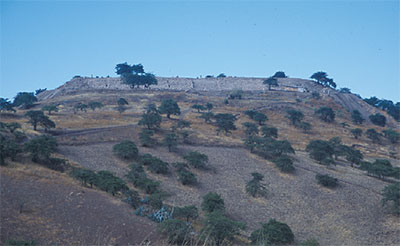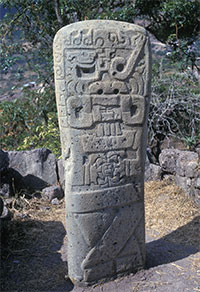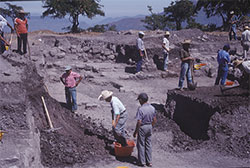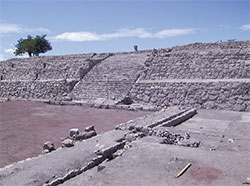The investigations of “Kuntur Wasi”, the archaeological site of a  religious center from the early stage of the Andean civilization, located in the northern highland of Peru, has been conducted by a Japanese team for over twenty years, since 1988. As a result of this excavation and research they attained numerous academic achievements through discoveries of buried gold decorative properties, believed to be the oldest on the American Continents, and a trace of temple-centered social living at that time, etc. On the other hand, this research generated a worthwhile cultural heritage resource which can be used in modern society through academic achievement, and a ‘social performance’ by establishment of the “Kuntur Wasi Museum”. In this way, I hope you will get to know that researching ruins is not merely about knowing the past, but also about how they are linked to and utilized in the present age.
religious center from the early stage of the Andean civilization, located in the northern highland of Peru, has been conducted by a Japanese team for over twenty years, since 1988. As a result of this excavation and research they attained numerous academic achievements through discoveries of buried gold decorative properties, believed to be the oldest on the American Continents, and a trace of temple-centered social living at that time, etc. On the other hand, this research generated a worthwhile cultural heritage resource which can be used in modern society through academic achievement, and a ‘social performance’ by establishment of the “Kuntur Wasi Museum”. In this way, I hope you will get to know that researching ruins is not merely about knowing the past, but also about how they are linked to and utilized in the present age.
1. Theme setting and selection of an archaeological site
There are an infinite number of ruins. What is your theme? Targeted age? State of preservation of a ruin? Comprehensively consider various elements and select a site to excavate.
2. Excavation and research
Excavation and research in the field. In order to obtain a large number of archaeological materials, we must take time to excavate. Excavation of a large site can take over 10 years.
3. Analysis and study of archaeological materials
Analysis of excavated materials. Conduct work in a workroom in the field, or in a laboratory at the university. Can take a similar amount of time as the excavation, or more.
4. Cultural heritage for modern utilization
Archaeological sites and materials are a precious cultural heritage for Peru. What kind of social contribution can be made by using them? Archaeologists are asked to contribute to modern society.
Professor of the Faculty of Liberal Arts, Sociology and Field Studies course
[Research field] Cultural anthropology, Andean archaeology
|
1964 |
Born in Mie Prefecture. |
|---|---|
|
1996 |
Full-time lecturer of the Faculty of Humanities, Niigata University (1999 Assistant Professor of the same university) |
|
2001 |
Assistant Professor of the Faculty of Liberal Arts, Saitama University |
|
2010- |
Currently; Professor of the Faculty of Liberal Arts, Saitama University |

(1)

(2)

(3)
(1) “Creativity of the ancient civilization – Temples and societies of the Andean civilization” (1998)
Co-authored, Kadokawa Corporation
(2) “The Andean civilization – The civilization that begins with temples” (2010)
Co-authored, Asahi Shimbun Publications Inc.
(3) “Gemelos pristinos: el tesoro del templo Kuntur Wasi” (“First twin: treasure of Kuntur Wasi”) (2011)
Editorial Fund of Congress of Peru, co-author Yoshio Onuki
Kuntur Wasi is the archeological site of a religious center from the early stage of the Andean civilization, located in the northern highland of Peru. The Japanese research team conducted repeated excavations and research there from 1988 to 2013. As a result, it was found out that Kuntur Wasi began around 950 BC, prospered until 800 BC to 300 BC, and then went into a rapid decline. What is the reason for its prosperity and decline? Many enigmas still remain, and research continues.


The Andean civilization is an ancient civilization that prospered in an area around current Peru and Bolivia in South America, and which ended because of the Spanish conquest of the Inca Empire in the 16th century. The first temple appeared in the Andes during the emerging period of civilization, which is approximately 4000 years before the Inca era.
current Peru and Bolivia in South America, and which ended because of the Spanish conquest of the Inca Empire in the 16th century. The first temple appeared in the Andes during the emerging period of civilization, which is approximately 4000 years before the Inca era.
The temple played an important role at the beginning of the civilization. In order to investigate the Andean civilization, from which no historic documents remain, Prof. Inokuchi left the laboratory, flew to South America, and excavated and researched the archaeological sites that remain.
 In the excavation and research of Kuntur Wasi, a total of eight special tombs with gold burial artifacts were discovered. These items date back more than 2000 years before the Inca Empire era, and are considered the oldest gold articles on the American Continents. Very artistically advanced motifs in which jaguars, snakes and humans are intricately mixed are drawn on the gold artifacts. These motifs are believed to have been deeply involved in beliefs and perspective of the world at that time.
In the excavation and research of Kuntur Wasi, a total of eight special tombs with gold burial artifacts were discovered. These items date back more than 2000 years before the Inca Empire era, and are considered the oldest gold articles on the American Continents. Very artistically advanced motifs in which jaguars, snakes and humans are intricately mixed are drawn on the gold artifacts. These motifs are believed to have been deeply involved in beliefs and perspective of the world at that time.
Clarifying the development background of civilization starting with a temple
Through accumulated studies of archaeological materials excavated from the ruins, one by one, it was found out that the temple played an important role at the beginning of the Andean civilization. Various activities associated with the temple generated social development; organizing a labor force to construct a temple strengthened the unity of the society. A leader was also generated. The temple required various professionals, and improved productivity was also required to take care of them. Burial ornaments in a special tomb contained many rare seashells and stones carried from places more than 1000 km away from the temple. An economic network also expanded from the temple.
However, such a society did not last forever. It was not only Kuntur Wasi. Temples all over the Andes were abandoned around 200 BC. Probably, various difficulties that could not be handled in a temple-centered society arose. Afterwards, a political leader with stronger power was generated, and a society aimed at farming-led economic development was born in the Andes.
International cooperation through cultural heritage
By excavating archaeological sites we do not only think of days long  past. In fact, archaeologists are deeply engaged in modern society through research of ‘cultural heritage’. In the wake of the discovery of unearthed gold artifacts in Kuntur Wasi, the local village gained momentum towards building a museum. Kuntur Wasi Museum, which opened in 1994, was constructed with the support of the Japanese government and private sectors. The museum is operated by residents, and the research team still plays a supporting role. This garners attention both in Japan and abroad as a good example of contributing to social development through cultural heritage and international cooperation.
past. In fact, archaeologists are deeply engaged in modern society through research of ‘cultural heritage’. In the wake of the discovery of unearthed gold artifacts in Kuntur Wasi, the local village gained momentum towards building a museum. Kuntur Wasi Museum, which opened in 1994, was constructed with the support of the Japanese government and private sectors. The museum is operated by residents, and the research team still plays a supporting role. This garners attention both in Japan and abroad as a good example of contributing to social development through cultural heritage and international cooperation.
Kuntur Wasi restored to the modern age
Some of the  architectures of the site were restored to the image of their original time through the UNESCO Japan Trust Fund. Today, people can visit Kuntur Wasi and see the temple of that time. They can also see archaeological materials such as unearthed gold artifacts, and clay pots in the museum. The restored temple and museum have become sources of local pride. After a long time, the temple, which was once a center for people in a long past age, has been revived as a symbol for local residents living in the modern age.
architectures of the site were restored to the image of their original time through the UNESCO Japan Trust Fund. Today, people can visit Kuntur Wasi and see the temple of that time. They can also see archaeological materials such as unearthed gold artifacts, and clay pots in the museum. The restored temple and museum have become sources of local pride. After a long time, the temple, which was once a center for people in a long past age, has been revived as a symbol for local residents living in the modern age.


© Copyright Saitama University, All Rights Reserved.